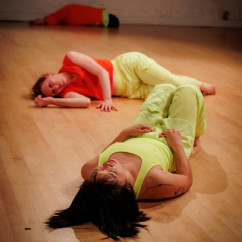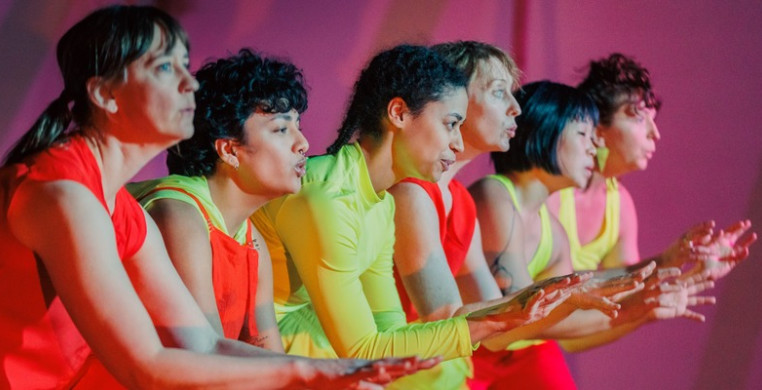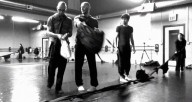The human experience is a tapestry woven with threads of opposing emotional states, each contrasting hue adding depth to the fabric. Joy goes hand in hand with sorrow, laughter coincides with tears, hope casts a light against despair and fear and courage are unlikely companions. Each emotion challenges another in the struggle for dominance over the human spirit. The true essence of humanity is revealed within the delicate balance of those opposing forces.
In their newest work, “Right Here,” Lucky Plush Productions (LPP) dismantles the chaotic tapestry of human emotion and plays with disparate parts. Links Hall serves as the playground for the ensemble members of LPP, along with musician Lex Leto, to create a world of exploration through modern dance choreography to contrast with improvisational structures, visual storytelling, and vocal expression.
The evening work was created and directed by ensemble member Melinda Jean Myers, and according to the program notes, “explores how the body holds opposing states of motivation and apathy, abundance and loss and hope and despair during a climate crisis.” Apart from deconstructed palm trees propped up against the back wall (elongated wooden beams with live plants attached to the top representing the fronds), the audience might not be aware of the work’s relation to the climate crisis. However, the ubiquitous fight in the human spirit between opposing emotions was presented with humor and clarity, and there was no doubt in the audience that this work was about all of us.
The piece began with a rich and velvety duet by seasoned LPP members Kara Brody and Meghann Wilkinson. Throughout their gentle movements, they revel in each other’s presence on stage, setting the tone for the evening. The ensuing dance language was soft and graceful. Dancers used their breath and voice to channel action through their bodies and to the viewer. It was clear that physical exertion was not the priority of the night, as dancers used their breath voices to channel action through their bodies.
 "Right Here," with Kara Brody; Photo by Sarah Elizabeth Larson
"Right Here," with Kara Brody; Photo by Sarah Elizabeth Larson
Leto's live music and vocals, built from a steady hum to a consistent and subtle melody, ebbed like water, drifting over the audience. The ensemble began to reflect the vocals of the musician, as they swept back and forth across the space towards Leto. Their bodies flowed through the space with long reaches of their arms and delicate spirals in their spines, creating a wave upon the shore of the Links Hall wood floor with the force of the ocean. There was a palpable sense of joy and ease that gave way to discord as their breaths became short and stifled, almost unbearable to execute. Not only did their breathing become shallow but the elongated movements that had been occurring turned into staccato jagged shivering, ending in an unnatural stillness.
The dancers began to tunnel through a plethora of human emotions, working through reactive sounds that might occur in different contexts. Surprising “ohs” melted into foolish “oohs” which gave way to a deep guttural belting, then macho animalistic grunting, “mmms” of satisfaction, confused “huhs,” finally landing with the expression of just one word, “okay”. They then began a repetitive articulation of the one-word phrase in varied inflections, feeding off of each other to find new ways of stating the word.
We often use “okay” to deflect from facing our own opposing emotions. Rather than “okay” being a true expression of how one feels, it fulfills the role of an emotional bandage. Rather than treating the underlying wound, we can cover it up and continue, maintaining a questionable homeostasis within our bodies.
 "Right Here," with Lucky Plush Productions; Photo by Sarah Elizabeth Larson
"Right Here," with Lucky Plush Productions; Photo by Sarah Elizabeth Larson
Throughout the work, the audience could relate to many moments. A solitary Jacinda Ratcliffe faced the audience, edging on a moment of action. Three of her yellow dancers began to give voice to the possible thoughts swimming through her head as she looked out at her audience. The voices guided her as she reacted through facial expressions of joy, confusion, disgust, happiness, and embarrassment. The hidden bodies began to walk her through the space. As Jacinda responded to the thoughts spoken on top of each other, a rip tide erupted from each voice, holding her back from any moment of peace.
The voices in our heads form an internal chorus, a cacophony of thoughts, beliefs, and emotions that shape our perceptions and guide our actions. Some voices whisper encouragement, while others can be critical and self-doubting. Amidst the clamor, there are echoes of past experiences, memories, and societal expectations, each vying for attention and influence to which the LPP dancers give physical life. We witness Jacinda learning to navigate this internal dialogue where harmony and discord intertwine, ultimately shaping her sense of self in front of us.
Another vital point in the work encounters the dancers all lying on the floor in an unrestful state, rocking side to side and shifting their weight as if they cannot become comfortable. Brody mutters from the ground that she should get up, yet cannot find the intention or energy to do so. She rises to her knees or feet in many attempts, only to be pulled back down again by her apathy. She rejects any motivation she garners for herself, the others emboldening her through their vocal agreement that she should get up. The fight between motivation and apathy takes form within the performers as these emotional opposites continue to hold sway over Brody’s direction sending her into a state of instability. LPP displays that within the depths of apathy lies the potential for awakening—a flicker of awareness that reminds us of our capacity for connection, empathy, and renewal.
While the ensemble danced with grace and great control, the standout moments of the performance were when the cast used vocal performance and visual storytelling to express a myriad of human emotions. “Right Here” is not a dance show meant to dazzle you with great feats of skill, but rather an hour spent reflecting on the absurdity of the inherent oppositional human emotions and our accountability towards them.
For more information on Lucky Plush Productions, click on the company link below.


